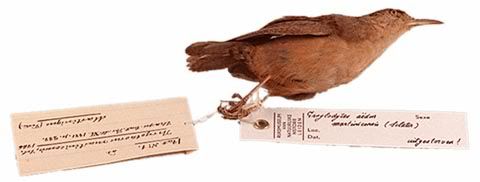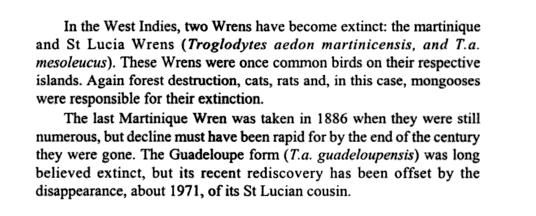|
|
Post by another specialist on Aug 23, 2007 21:55:51 GMT
|
|
|
|
Post by another specialist on Aug 23, 2007 21:56:15 GMT
Troglodytes aedon martinicensis last seen in 1886
|
|
|
|
Post by another specialist on Aug 23, 2007 21:56:45 GMT
sebbe wrote Martinique wren Not too fond of people The last record of a Martinique Wren Troglodytes aedon martinicensis Sclater, 1866 dates from 1886. This subspecies of the House Wren appeared to be rare as early as in 1879, when it was reported to occur in the forests of the hills and riverbanks on the island of Martinique. Apparently, the bird avoided human settlements. This is quite surprising, considering that on the mainland House Wrens live in towns and gardens. Probably the Martinique Wren was exterminated by rats, cats and mongooses before it had the chance to adapt itself. Closely related wrens on Grenada, however, did not suffer from the introduction of these animals. Martinique Wren. It didn't live to see Mount Pelée erupt It is sometimes suggested that the eruption of Mount Pelée in 1902 caused the extinction of the wren. Most certainly it did have a disastrous effect on the fauna of the island. It may have caused, for instance, the extinction of the Martinique muskrat. However, almost certainly the Martinique Wren had already vanished before 1902. The museum collection Specimens of the Martinique Wren are kept in Tring, Chicago, New York and Cambridge ( Massachusetts). Nothing is known about the provenance of the skin in the National Museum of Natural History, except that it is from Martinique. www.naturalis.nl/300pearls/ |
|
|
|
Post by another specialist on Aug 23, 2007 21:57:09 GMT
 from above website |
|
|
|
Post by another specialist on Aug 23, 2007 21:59:15 GMT
carlos wrote Martinique Wren Troglodytes aedon martinicensis Sclater, 1866 RMNH 110.001: adult, Martinique. Exterminated by rats and cats The last record of a Martinique Wren dates from 1886. This subspecies of the House Wren appeared to be rare by 1879, when it was reported to occur in the forests of the hills and riverbanks on the island of Martinique. Apparently the bird avoided human settlements. This is quite surprising, considering that on the mainland House Wrens live in towns and gardens. Probably the Martinique Wren was exterminated by rats, cats and mongooses before it had a chance to adapt itself. Closely related Wrens on Grenada did not suffer from the introduction of these animals. The eruption of Mount Pelée in 1902, by some supposed to have caused the extinction of the Wren, certainly did have a disastrous effect on the fauna of the island: it may have caused, for instance, the extinction of the Martinique Muskrat. However, almost certainly the Martinique Wren had already vanished before 1902. Museum specimens Specimens of the Martinique Wren are kept in the United Kingdom (Tring), Chicago, New York and Cambridge (Massachusetts). Nothing is known about the provenance of the skin in the Leiden Museum, except that it is from Martinique. ip30.eti.uva.nl/naturalis/detail?lang=uk&id=2 |
|
|
|
Post by another specialist on May 3, 2009 19:43:01 GMT
 Encyclopaedia of Birds By Arvind N. Shukla, Rajiv Tyagi |
|
|
|
Post by surroundx on Sept 18, 2016 13:49:03 GMT
|
|
|
|
Post by Sebbe on Nov 11, 2022 16:01:01 GMT
|
|